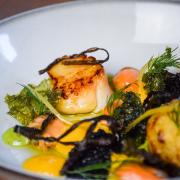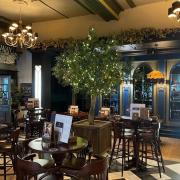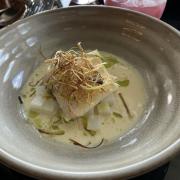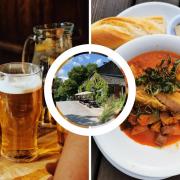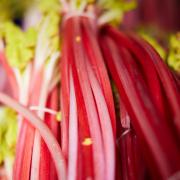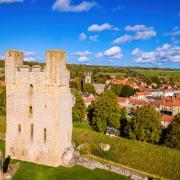Yorkshire fisherman Bob Roberts is taking lobster to a new level with plans for a gourmet lobster oil

It’s mid-morning and the West pier café in Scarborough is alive with laughter and good natured banter. Bob Roberts, ruddy white-bearded face beaming, is clock-watching between retorts: his fishing boat, Capernaum, is due in any time and he’s itching to see the catch of the day.
He doesn’t have to wait long: the vessel is spotted heading briskly into harbour where it moors beneath the winch that lifts the cartons of squirming lobsters onto dry land. After a quick check, Bob whisks them away to be stored – carefully handled and sized - in specially created cool water boxes.
Most of them are destined for the region’s finest restaurant kitchens or individuals who value The Yorkshire Lobster Company’s artisan sea-to-table approach – an ethos that takes traditional shellfishing back to its roots. But there are some which will have an altogether different role to play on the gourmet menu.
Forward-thinking Bob has teamed up with Thixendale rape seed farmers Charlie and Ivy’s, along with Whitby based chef and UK ambassador for Seafish Rob Green, to develop lobster oil – lobster infused rape seed oil which should hit the shelves by the end of the year.

‘It’s popular in the States but there are very few people producing lobster oil in the UK,’ says Bob. ‘Yes it makes a lot of sense for the farming and fishing industries to work more closely together.’
In spite of his growing success, Bob has only been lobster fishing seriously for around three years.
‘It started as a challenge, perhaps even a hobby, ’ says Bob, whose ancestors were seamen and who has himself spent several years in Naval submarines followed by 30 years in underwater construction. ‘My father and grandfather didn’t want my brother Allan and I to go into the fishing industry. They said it was too tough, too uncertain, but you can’t ignore what’s in your blood. There’s a certain romance to it. Fisherman are the last hunters, if you like, but the fishing industry has changed dramatically. There used to be trawlers in the harbour, now it’s all about shellfish. I wanted to focus on lobsters because there were plenty of people already catching crabs. There’s a bit of mystique about lobsters, and I wanted to make them accessible to everyone.’
Bob acknowledges that the lobster is an intriguing creature: Both beautiful and barbaric, it changes from shades of black and brilliant blue to orange-crimson in the pot, it has cannabilistic tendancies, can sever a human finger with its claws and eats its own discarded shell which it changes once a year. Its teeth are in its stomach – and a nine pound female can carry 100,000 eggs at a time. They are as mysterious as they are delicious: an enigma even to experts like Bob.

The method for catching lobsters, however, is more straight forward and has changed little over the centuries.
Bob uses metal framed lobsters pots which the fishermen wind with coloured ropes - a process which can take up to a day – to create two compartments, the entrance and the ‘parlour’. The lobsters are lured in with rotten bait (unlike crabs which prefer fresh) and end up in the ‘parlour’ from which there is no escape. Bob has around 1,000 pots which can last up to 10 years. They can be dropped anywhere, but Bob’s two-man crew focuses on the land rock close to the shore, and also the rock edge of the Continental Shelf which is about six miles out to sea for crabs. On this particular morning they set off at 4am and return around lunch time, bearing a mix of lobsters - and crab which are sold onward to shellfish merchants and to fishermen to sell on.
Where to eat seafood in Yorkshire - check out our guide here

‘Whilst I only sell lobsters we try help each other out,’ says Bob. ‘There is a good community here. We all know it’s tough, but we’re all in the same boat, if you’ll pardon the pun, and we all have the future of the fishing industry at heart. Our approach to sustainably sourced lobster ensures that the stocks in the Yorkshire seas are well cared for. I won’t sell ‘Berried Hens’ - lobsters that are carrying eggs. A lobster will reach it’s mating maturity long before it is legal for it to be caught, so we always take care when handling our lobsters. Sustainability is at the heart of our business, now and for future generations.’
The future of the lobster may be looking rosier thanks to people like Bob, but he still has an uphill challenge to convince the British public that this succulent shellfish is as accessible and affordable as a decent steak.
‘A lot of people think they are too expensive and difficult to prepare, but it’s all a myth,’ he says. ‘The reality is that while 95% of our lobsters go to Spain and France, people here are only just waking up to the fact that our seas are full of fantastic, delicious, easy to cook shellfish like lobster.’
Bob is certainly on a mission to bridge the gap between sea and plate, calling himself ‘the little fella’ who supplies fresh seafood directly to the table – often via the gastro pubs whose chefs are queuing up to buy his daily catches.
‘I want to make these changes to help improve the lives and livelihoods of our local fishing community,’ he says.
The Yorkshire shellfish industry is one of the finest in the world, with Bridlington being the biggest shell fishing port in Europe and Scarborough the second largest.
‘It’s a bit of struggle getting support from our local authority,’ says Bob. ‘Revenue from catches makes a valuable contribution to exports and the economy. Sadly it not really recognised locally. We have to work together and stand up for what we believe in. Fishing has been a part of our heritage for hundreds of years and we must fight for its future.’
It’s Bob’s way of bringing his seafaring family history full circle. And it’s that history which also inspired the name of his boat, the Capernaum.
His mother was a direct descendant of two crew members who perished in May 1894 when the yawl ‘Capernaum’ was run down off Flamborough, just south of Scarborough, by the barque ‘Polynesian’, with the loss of all hands. After a brief search for survivors, the Polynesian carried on to Brazil with her cargo of coal before the incident was finally reported. A subsequent inquiry led to the suspension of the ship’s master and chief officer. Local memorials to Bob’s lost descendants are a salutory reminder of the perils of the industry – and the reason why he can’t ignore the lure of the sea.
‘I remember my first time in a boat – I was 12 and the boat was called ‘Golden Crest. I went line fishing and loved the sense of space, openness and isolation,’ says Bob. ‘My grandfather was spitting feathers when I got home; but I loved it. I knew then that it was in my blood. It took me a long time to recognise it and to turn it into a living, but now it’s not only my job – it’s a way of life.’
Lobster Trivia
* Lobsters do not have vocal chords.
* The teeth of the lobster are in its stomach, which is a very short distance from the mouth
* A freshly laid lobster egg is the size of the head of a pin
* When the eggs hatch, the larvae will float near the surface for 4 to 6 weeks. The few that survive will settle to the bottom and continue to develop as baby lobsters.
* From every 50,000 eggs only 2 lobsters are expected to survive to legal size.
* No one has yet found a way to determine the exact age of a lobster. However, based on scientific knowledge of body size at age, the maximum age attained may approach 100 years.
* They can grow to be 3 feet or more in overall body length.
* Lobsters have no vocal chords, possess two stomachs, and have been known to eat each other.
* Lobsters were once so plentiful that they could easily be caught right at the shore and were eaten mainly by poor people.




